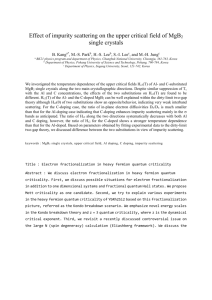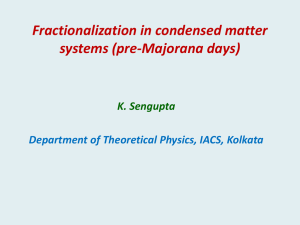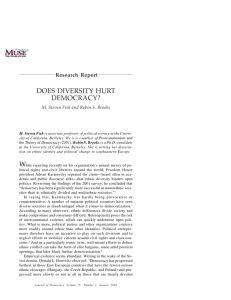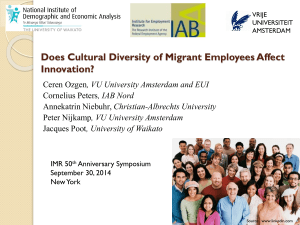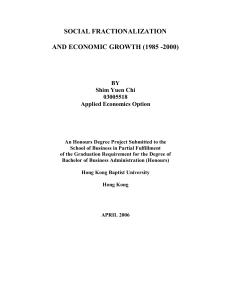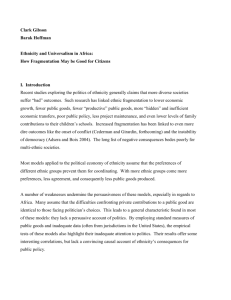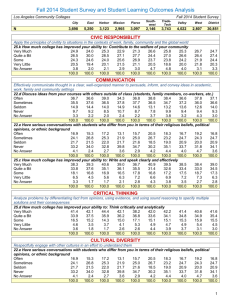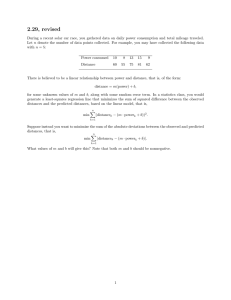Fractionalization and inter-group differences ∗ Jo Thori Lind August 12, 2005
advertisement
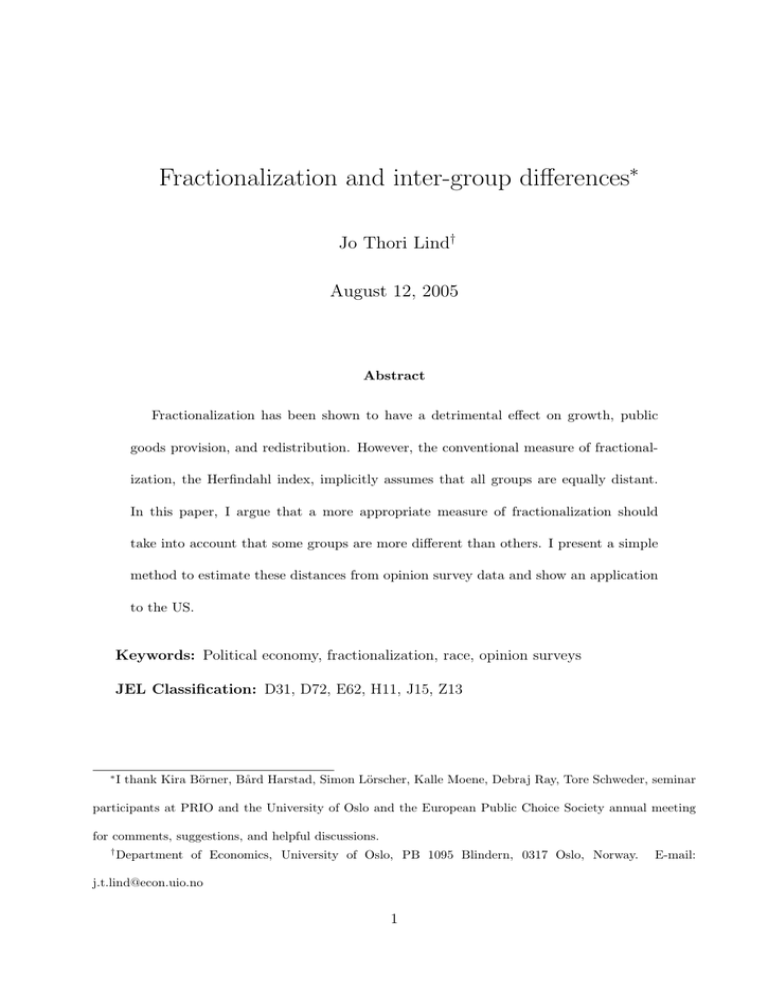
Fractionalization and inter-group differences∗
Jo Thori Lind†
August 12, 2005
Abstract
Fractionalization has been shown to have a detrimental effect on growth, public
goods provision, and redistribution. However, the conventional measure of fractionalization, the Herfindahl index, implicitly assumes that all groups are equally distant.
In this paper, I argue that a more appropriate measure of fractionalization should
take into account that some groups are more different than others. I present a simple
method to estimate these distances from opinion survey data and show an application
to the US.
Keywords: Political economy, fractionalization, race, opinion surveys
JEL Classification: D31, D72, E62, H11, J15, Z13
∗
I thank Kira Börner, Bård Harstad, Simon Lörscher, Kalle Moene, Debraj Ray, Tore Schweder, seminar
participants at PRIO and the University of Oslo and the European Public Choice Society annual meeting
for comments, suggestions, and helpful discussions.
†
Department of Economics, University of Oslo, PB 1095 Blindern, 0317 Oslo, Norway.
j.t.lind@econ.uio.no
1
E-mail:
1
Introduction
Fractionalization has caught a lot of attention among economists and other social scientists
in recent years. The concept is usually defined as the probability that two randomly chosen
persons belong to different groups, be it ethnic, religious, linguistic, or other groups. Studies
have shown that fractionalization leads to more corruption (Mauro 1995), low growth and
bad policies in general (Easterly and Levine (1997), low provision of public goods (Alesina,
et al. 1999), less redistribution (Alesina et al. 2001, Lind 2005), less social mixing and
activity (Alesina and La Ferrara 2000), lower voluntary contributions to schools (Miguel
2003, Miguel and Gugerty 2003), and higher prevalence of civil war (Elbadawi and Sambanis
2002, Reynal-Querol 2002).1
To study the effect of fractionalization, it is crucial to measure it properly. Most existing
measures of fractionalization are only partially successful in this respect. My objective is to
develop a method to construct better measures of fractionalization.
The first step to measure fractionalization is to choose the partitioning of the population
into groups. The majority of studies use data on ethnic and linguistic groups collected by
Soviet anthropologists in the 1960s reported in the Atlas Narodov Mira, and compiled into
a measure of ethno-linguistic fractionalization usually referred to as ELF. Posner (2004),
among others, have criticized the groups used by the Atlas. He argues that some groups
that are actually the same have been grouped as different whereas groups that are arguably
distant are grouped together. Alesina et al. (2003) and Fearon (2003) have recently compiled
broader data sets with data of higher quality, at least for the purposes of studies of the
consequences of fractionalization. But as Fearon (2003: 197) states, “It rapidly becomes
1
A more detailed survey of this literature can be found in Alesina and La Ferrara (2004)
2
clear that one must make all manner of borderline-arbitrary decisions, and that it many
cases there simply is no right answer to the question: “What are the ethnic groups in this
country?””, so a correct way of calculating fractionalization has not yet been found.
For most societies, there are some group partitions that matter for politics, and a large
number of other possible partitions that have no relevance for politics. Also, for a given
partition, it may be that the division between some groups is more important than the
division between others. One way to put the problem is to say that the distance between
groups is not necessarily the same between all groups. If we have a concept of distance
between groups, this may also help us tell what groups we should use in a proper analysis of
fractionalization. If the distance between two groups is small, the splitting into two groups
may not be relevant. If it is large, the partitioning is relevant.
The aim of the present paper is to make a first attempt at estimating the distance
between groups using data from opinion surveys. The method I suggest is based on estimated
differences in opinions on a set of political questions. We regress a measure of political
opinions, such as whether expenditure on some public good should be increased or not, on
dummies for belonging to the groups of a potentially salient partition of society as well
as a vector of control variables. If members of different groups have significantly different
opinions, controlling for other characteristics, this indicates that groups in general have
different opinions on this dimension of politics, and hence that they are different. Comparing
the magnitude of the coefficient among groups, we can construct a measure of distance
between groups.
There are usually several relevant opinion questions we wish to include, and each question will in general give a separate measure of inter-group distances. To aggregate these
coefficients, I suggest to locate groups in a space with dimensionality equal to the number of
3
question and the coordinates being given by the estimated coefficients. Then the aggregate
distance between groups can be calculated as the distance between points in this space.
The appropriate choice of which questions to study depends on the final objective of the
study. For a study of the effect of fractionalization on public goods provision question relating
to public policy are of crucial interest. If the objective is the effect of fractionalization on
the prevalence of civil war, such questions may be less relevant.
The paper relates to the body of literature studying the consequences of fractionalization
on different outcomes mentioned above. On the theoretical level, it relates closely to the
work of Caselli and Coleman (2002). They present a model of coalition formation where
the success of the formation depends on being able to exclude others. They argue that
this is most likely if the coalition is formed by one ethnic groups that is more distant from
other ethnic groups. As strong coalition leads to more rent seeking activity, larger distance
between groups is economically detrimental.
Recently, a literature attempting to construct better measures of fractionalization has also
emerged. One improvement is the updating and increased coverage provided by Alesina et al.
(2003) and Fearon (2003). Another is in the measurement of ethnicity and fractionalization.
The fundamental task of placing individuals in ethnic groups, which is required for calculating ethnic fractionalization, is in itself not trivial. As pointed out by Posner (2000), a
person’s self classification depends on his current context. He suggests a methodology where
he creates a uniform context by means of a recorded dialogue before asking respondents
about their ethnicity. Nopo et al. (2004) measure respondents intensity along several racial
characteristics by physical characteristics. Bannon et al. (2004) use self reported data on
which group people feel they belong to, and study who report that their belonging is to their
ethnic group.
4
Posner (2004) argues that the grouping of ethnicities found in the standard sources of
data is inappropriate. Some groups are strictly speaking different groups, but cooperates
well so they should not be counted as separate. Going through a large amount of literature
on each country, he constructs a measure of relevant ethnic groups for a number of African
countries. The problem with this approach is mostly the large workload and the difficulty of
replicating the data construction. The methodology I derive in this paper is also suitable to
identify which groups are very close and which are further apart, so it serves as an alternative.
There is a small literature that attempts to estimate the distance between different linguistic groups, starting with Greenberg’s (1956) seminal paper. He suggested to calculate
the distance between two linguistic groups (actually two languages) as the fraction of a fixed
basic vocabulary, taken from a glottochronology or Swadesh list, that are common between
the two. As this approach to linguistics has lost most of its popularity, it has not been
pursued much further. Fearon and Laitin (Fearon and Laitin 1999, Laitin 2000) has pursued
a related direction where they measure the distance between languages by their distance
in linguistic trees. If two languages belong to different language families, they obtain the
maximum distance and if they are closely related they get a smaller distance. The drawback
with this approach for measuring fractionalization is that two groups may have very different languages but still work perfectly well together, and another society may have groups
that speak almost the same language, such as Serbian and Croatian, but still be unable to
cooperate.
5
2
An improved measure of fractionalization
The conventional measure of fractionalization is the Herfindahl measure
H =1−
N
X
qi2 ,
(1)
i=1
where there are N groups and qi is the fraction of the population belonging to group i.
This measure gives the probability that two randomly chosen individuals belong to different
groups. Implicit in this measure is that if two persons belong to the same group, they are
in some way identical. If they are from two different groups, the difference between the two
is the same independently of which groups they belong to.
However, it is often the case that some groups are close and other more remote. Panel a of
Figure 1 depicts the case where H may be appropriate. Here, all three groups have the same
distance. If we say that each group consists of 1/3 of the population, total fractionalization
is 2/3. In panel b, groups B and C are closer. Here H would still give a fractionalization of
2/3. In panel c, however, groups B and C are even closer together and have merged to one
group. Now H measures fractionalization as 4/9. This illustrates two difficulties with the
Herfindahl measure H. First, if some groups are close to each other, this should be reflected
in the measure of fractionalization, so fractionalization in case b should be lower than in
case a. Second, there is a discontinuity in the measure. It is often not clear exactly how
many groups we should have. We could have groups that are close. Then fractionalization
should not change abruptly if we put them in two different groups, as in panel b, or in one
group, as in panel c.
An example of division where the distance is small could be the Norwegian division
between bokmål and nynorsk speakers. The two languages are very similar, and speakers
of one language can easily understand speakers of the other language. Still both have the
6
Figure 1: Different cases of group division.
status of official languages. With approximately 15% nynorsk users2 , this gives a Herfindahl
measure of 0.26. We can compare this with for instance the Basque minority in Spain3 ,
which only makes up 1.6% (Alesina et al. 2003) and hence yields a Herfindahl measure of
0.03. Most observers would agree that the linguistic fractionalization in Norway has virtually
no effect whereas the fractionalization in Spain is a salient conflict. The reason is of course
that the distance between the two linguistic groups in Norway is small whereas the distance
between the groups in Spain is much larger.
An extension of (1) that can solve these problems is
F =
N X
N
X
dij qi qj ,
(2)
i= j=1
where dij is a measure of the distance between group i and j. It is natural to assume that
dii = 0, i.e. that each group is homogeneous. Also, we usually have symmetric distances,
so dij = dji . In Figure 1, panel a would correspond to the case where all the distances
2
To the best of my knowledge, there are no exact measures of the population using nynorsk, partly
because some use both. The number is based on the fraction of pupils using nynorsk (Statistics Norway
2004).
3
One could argue that other Spanish minorities, e.g. the Catalans, should be considered separate groups.
However it seems that the conflict between the Basques and the remainder is more salient.
7
dij , i, j ∈ {A, B, C} are unity, so fractionalization is 2/3 as with the Herfindahl measure.
In panel b, however, we still have dAB = dAC = 1, but now dBC < 1 so fractionalization is
below 2/3 as measured by the measure F . As the distance dBC shrinks, we converge to the
case depicted in panel c, where dBC = 0 in a logical way.
3
Relation to existing measures
It is easily seen that the new fractionalization measure F reduces to the Herfindahl measure
H if we choose the distance function
dij =
0 if i = j
,
(3)
1 if i 6= j
which implies that the distance is the same between all groups.
It has been suggested that some features are better explained by polarization than fractionalization. The measure F can be extend to encompass the class of polarization measures
introduced by Esteban and Ray (1994). If we define
α
F =
N X
N
X
d(kj ,li ) ijqi1+α qj ,
i= j=1
we would get their measure of polarization4 for α ∈ (0, α∗ ] and the measure of distance
polarization with α = 0. If we set α = 1.5 and restrict d to be the binary metric (3), which
is also used for the Herfindahl index, we get the measure of group polarization suggested by
Reynal-Querol (2002). I conjecture that one way to derive this measure theoretically could
be through Esteban and Ray’s (1999) model of the effect of polarization on conflict.
4
Where α∗ is some constant ' 1.6.
8
4
Measuring inter-group distance
The measure of fractionalization F introduced in (2) is theoretically appealing, but not
applicable for practical purposes unless we find a way to determine the distances dij between
groups. One could think of several ways to measure distances between groups, and it is likely
that different measures would be appropriate for different purposes.
One approach that is widely applicable is to use stated preferences on policy questions.
If members of different groups have very different opinions on these questions, holding other
characteristics constant, this indicates that there is a large distance between these groups.
Of course, it can be the case that they have very different opinions on some aspects of
politics and more similar views on other aspects. This would then mean that they have a
large distance along some dimensions, but are closer along other dimensions. For instance,
one measure of inter group distances may be appropriate for studying provision of public
goods, but not for the probability of violent conflict.
Here I show how we can use opinion survey data to measure the distance between a given
group and a reference group. If we regress respondents’ opinion on some political question,
such as whether public goods provision is too high or too low, on a vector of standard
control variables and dummy variables for the respondent’s group, the coefficient on the
group dummies can be interpreted as the distance between the group and the reference
group (the omitted category).
If the estimated parameters for two groups are very similar, so their distance is estimated
to be small, this shows that these groups tend to have similar opinions on this question and
hence that a coalition of these two groups is likely. Which potential coalition formation we
are interested in depends on the ultimate goal of our analysis, and determines the appropriate
9
choice of questions to analyse.
If Yi is an indicator of opinions on some policy issue, gij an indicator of individual i
belonging to group j and zi a vector of control variables, we run a regression of the form
Yi = α +
X
δ j qij + γ 0 zi + εi .
(4)
j
If we let group 0 be the reference group and impose δ 0 = 0, we can define the distance
between group j and group k as |δ j − δ k |.
A difficulty with this approach is that there will usually be several questions on opinion
that are useful to characterize distances between groups and a lot of information will disappear if we only choose to use one indicator. This means we actually want to estimate a
system of the form
P
0
Y
=
α
+
i1
1
j δ j1 qij + γ 1 zi + εi1
..
,
.
P
YiT = αT + j δ jT qij + γ 0T zi + εiT
i.e. one equation for each of T opinion indicators. For each group j we then have T distance
indicators δ jt , and we usually want to aggregate these into a single distance measure. A
simple way to do this is to let each of the T indicators represent a dimension in Euclidean
space, so (δ j1 , . . . , δ jT ) is group j’s location. The case of three groups and two indicators is
shown in Figure 2. Here group 0 and 1 are clearly the furthest apart. Group 2 is closest to
group 1 along dimension 1 and closest to group 0 along dimension 2. The overall distances
between the groups djk is determined as the distance between the points.
Although the situation is more difficult to depict graphically, it is straightforward to
analyse the situation with more than two opinion indicators. The aggregate distance measure
10
Figure 2: Estimation of inter-group distance.
is then calculated by the Euclidean metric
s
djk =
X
(δ j − δ k )2 .
(5)
t
This could be extended to other metrics as well as different weighting schemes, but as it is
usually difficult to choose these, I prefer to stick to the simple method.5
5
A different approach would be to first estimate a racial index ri and then use this in the opinion
11
5
An application to US data
A rich data set that permits estimating inter-group distances is the US General Social Survey
(GSS). I use this to estimate a politically relevant measure of the distance between the groups
of African Americans, Whites, and Others. The GSS, which is an annual omnibus-type
survey which has been conducted since 1972, contains a number of questions on opinions of
public policy that may seem relevant for estimating inter-group distances. Table 1 gives an
overview of the opinion questions I use.
Table 1 about here
I regress each of these measures on dummies for race, which is likely to be the most
relevant group decomposition in the US case, as well as a set of other variables we believe
have an impact on opinions as in equation (4). Results from these analyses are reported
in Table 2. To keep matters as simple as possible, I use a linear probability model even
regression. Specifically, we can think of this as a model on the form
yit
ri
= αt + β t ri + γ 0t zi + εit
=
X
δ j qij
j
Stacking vectors by question we can rewrite the model as
yi = α + Φdi + γzi + εi
where we have the restriction Φ = βδ, which essentially entails that Φ should have rank 1. This is a problem
of reduced rank regression introduced by Anderson (1951); see e.g. Reinsel and Velu (1998) for an updated
and more accessible treatment. Estimation is carried out by first using the Frisch-Waugh theorem to partial
out the control variables zi . An unrestricted version of Φ is obtained by OLS, and then δ is obtained as a
vector weighted average of the unrestricted Φ. Estimation results from this method is provided in Appendix
table 1.
12
though the respondents give ranges of answers. Details of the coding can be found in Table
1. Generally, I have tried to code an answer that could be seen as liberal as a positive
outcome.
Table 2 about here
On all issues except tax policy, African Americans seem to have a more liberal view than
Whites as their coefficient is positive, and also significant. This is also the case for the Other
group on most issues, but here not all estimates are significantly different from zero. This
shows that political opinions tend to be more homogeneous within one racial group than in
the population as a whole. This coefficient on the group dummies may be interpreted as the
distance between the group and Whites, and the distance between African Americans and
Others would be found as the (absolute value of the) difference of the coefficients on the two
groups. However, now we have a large number of distance measures, which is awkward in
itself. Furthermore, it is not trivial to decide what measure to use for a particular issue.
Table 3 about here
To try to construct a more useful measure of distance, we can first notice that there
is a high degree of association between the different questions in the battery to measure
opinions. Table 3 show the results from a factor analysis of the answers. We see that there is
one dominant factor, which seems to correspond reasonably well to the liberal/conservative
distinction. Now, we could extract this factor, and use this as the explained variables rather
than the whole battery. However, the control variables have different impacts on different
opinion questions. As it is crucial to control for other factors to get an estimate of group
membership proper on opinions, this could lead to flawed estimates. Hence the Euclidean
metric (5) is calculated from the estimates reported in Table 2. The resulting aggregate
13
distances are reported in Table 4.
Table 4 about here
These estimates would be useful to construct a measure of fractionalization for the whole
of the US. However, to get a better grasp of the performance of the procedure, it is useful to
introduce some cross sectional variation. To do this, I assume that the distance parameters
δ jk may vary across census regions. Using a similar technique as the one used to produce
Table 4 gives the distance measures shown in Figure 1. The three first panels show the
distances between the three groups geographically, whereas the last panel show the actual
numbers of the distances between African Americans and Whites and Whites and Others.
Now it is time to return to the original task, that of constructing a theoretically more
appealing measure of fractionalization. Using population estimates for 20036 , it is straightforward to construct the measure of distance fractionalization F using the distance estimates
above. Figure 2 shows the geographical distribution of the traditional Herfindahl measure
of fractionalization and the new distance measure as well as a plot of the two against each
other. We see that the two measures are highly correlated (the correlation coefficient is
.90). To get a grasp of the differences between the two measures, the last panel shows the
geographical distribution of residuals from a regression of distance fractionalization on the
Herfindahl measure. If these residuals are positive, it indicates that the Herfindahl index
underestimates the fractionalization in this state and vice versa for negative values. We
see that the Herfindahl measure tends to overestimate the degree of fractionalization on the
West Coast and more markedly in Hawaii and Alaska. It tends to underestimate the level
of fractionalization in most of the South. This conforms well with the received wisdom that
6
Taken from http://www.census.gov/popest/states/asrh/tables/SC-EST2003-04.xls
14
African American − Other
.6
.65
Mountain Division
New England
[0.24,0.26]
(0.26,0.35]
(0.35,0.41]
(0.41,0.93]
.85
.9
East North Central
West North Central
.7
.75
.8
Distance African American − White
Pacific Division
South Atlantic
West South Central
Middle Atlantic
East South Central
White − Other
The maps show distance between racial group estimated as the Euclidean distance using the results from the regressions.
[0.53,0.65]
(0.65,0.67]
(0.67,0.78]
(0.78,1.17]
[0.59,0.60]
(0.60,0.68]
(0.68,0.77]
(0.77,0.85]
African American − White
Figure 3: Estimates distances between racial groups.
1
Distance White − Other
.6
.8
.4
.2
15
.4
Distance fractionalization F
.1
.2
.3
0
[0.06,0.18]
(0.18,0.26]
(0.26,0.38]
(0.38,0.52]
.1
NH IA UT
VT WV
ME
IDWY
NM
WA
NV
.2
.3
Herfindahl index
KY IN
RI
WIKS
MN
AZ
NE CO
SD
MT
ND OR
MO
OH
CT TX
MA
PA
MI
AR
FL
TN
Herfindahl index
IL
OK
CA
DE
NJ
.4
HI
AK
NC NY
VA
AL
.5
SC
GA MD
LA
MS
DC
[−0.07,−0.04]
(−0.04,−0.01]
(−0.01,0.03]
(0.03,0.19]
[0.03,0.09]
(0.09,0.15]
(0.15,0.23]
(0.23,0.39]
Difference
Distance fractionalization
Figure 4: Fractionalization across states
the Herfindahl index underestimates fractionalization.
The panel Difference show the residuals from a regression of distance fractionalization on the Herfindahl index. A positive value indicates that
0
16
racial conflict is more intense in the South than along the West Coast.
6
Conclusion
In this paper, I argue that the conventional measure of fractionalization, the Herfindahl
index, is too simplistic, and suggest a more general measure that gives the average distance
between groups. This reduces to the conventional measure if the distance between all groups
is identical.
To estimate between group distances, I derive a method based on regressing political
opinions on dummies for group membership. If a dummy variable on a given group have a
large coefficient, other explanatory factors controlled for, it indicates a large distance between
the groups. As there are several opinions we would like to use for such measurement, we
need to combine these measures into a single measure of distance. I show how to do this by
letting the different political issues correspond to dimensions in an Euclidean space.
I used this approach to construct new measures of fractionalization for US states based on
opinion data from the GSS. The new data seem to give a better picture of fractionalization
than the conventional measure.
In future work, it would be very useful to construct measures of inter-group distance
and distance-fractionalization on a broader sample of countries. The challenger is to get
comparable opinion data for an interesting sample of countries. Some fairly uniform multicountry opinion surveys have emerged (World Values Survey, Afrobarometer) and could be
potential sources of such data. However, the data coverage for developing countries is still
fairly low.
17
References
Alesina, A., R. Baqir, and W. Easterly (1999): “Public goods and ethnic division.” Quarterly Journal of Economics 114: 1243-84.
Alesina, A., A. Devleeshauwer, W. Easterly, S. Kurlat, and R. Waciarg (2003):
“Fractionalization.” Journal of Economic Growth 8: 155-94.
Alesina, A., E. Glaeser, and B. Sacerdote (2001): “Why doesn’t the US have
a European-style welfare system.” Brookings Papers on Economic Activity
187-278.
Alesina, A., and E. La Ferrara (2000): “Participation in Heterogeneous Communities.” Quarterly Journal of Economics 115: 847-904.
Alesina, A. and E. La Ferrara (2004): “Ethnic diversity and economic performance.” Mimeo, Harvard University.
Anderson, T. W. (1951): “Estimating linear restrictions on regression coefficients
for multivariate normal distributions.” Annals of Mathematical Statistics 22:
327-51.
Bannon, A., E. Miguel, and D. N. Posner (2004): “Sources of ethnic identification
in Africa.” Mimeo, Berkeley.
Easterly, W., and R. Levine (1997): “Africa’s Growth Tragedy: Policies and
Ethnic Divisions.” Quarterly Journal of Economics, 112: 1203–1250.
Elbadawi, I., and N. Sambanis (2002): “How much civil war will we see?” Journal
of Conflict Resolution 46: 307-34.
Esteban, J.-M. and D. Ray (1994): “On the Measurement of Polarization.”
18
Econometrica 62: 819-51.
Esteban, J.-M. and D. Ray (1999): “Conflict and distribution.” Journal of Economic Theory 87: 379-415.
Fearon, J. D. (2003): “Ethnic and cultural diversity by country.” Journal of
Economic Growth 8: 195-222.
Fearon, J. D., and D. D. Laitin (1999): “Weak states, rough terrain, and largescale ethnic violence since 1945.” Mimeo, Stanford University.
Greenberg, J. H. (1956): “The measurement of linguistic diversity.” Language
32: 109-15.
Laitin, D. D. (2000): “What is a language community?” American Journal of
Political Science 44: 142-55.
Lind, J. T. (2005): “Fractionalization and the size of government.” Mimeo, University of Oslo.
Mauro, P. (1995): “Corruption and Growth.” Quarterly Journal of Economics,
110: 681–712.
Miguel, E. (2003):
“Tribe or Nation? Nation-Building and Public Goods in
Kenya versus Tanzania.” Unpublished paper.
Miguel, E. and M. K. Gugerty (2003): “Ethnic Diversity, Social Sanctions, and
Public Goods in Kenya.” Unpublished paper.
Nopo, H., J. Saavedra, and M. Torero: “Ethnicity and earnings in Peru.” Mimeo,
Middlebury College.
Posner, D. N. (2000): “Measuring ethnic identities regarding inter-group rela19
tions: Methodological pitfalls and a new technique.” Mimeo, UCLA.
Posner, D. N. (2004): “Measuring ethnic fractionalization in Africa.” American
Journal of Political Science 48: 849-63.
Reinsel, G. C., and R. P. Velu (1998): Multivariate Reduced-Rank Regression.
Theory and Applications. New York: Springer.
Reynal-Querol, M. (2002): “Ethnicity, Political Systems, and Civil Wars.” Journal of Conflict Resolution 46: 29-54
Statistics Norway (2004): “Grunnskoleelevar, etter elevens målform og fylke. 1.
oktober 2002”, http://www.ssb.no/aarbok/tab/t-040220-183.html (accessed
20.4.05).
20
Table 1: Questions on political opinions
Liberal
Question
Self classification of liberal or conservative
Environment
Spending on Improving and protecting the environment
Health
Spending on improving and protecting the nation's health
Cities
Spending on solving the problems of the big cities
Crime
Spending on halting the rising crime rate
Drug
Spending on dealing with drug addiction
Education
Spending on improving the nation's education system
Race
Spending on improving the condition of Blacks
Foreign aid
Spending on foreign aid
Welfare
Spending on welfare
Roads
Spending on highways and bridges
Arms
Spending on military, armaments, and defense
Transport
Spending on mass transportation
Parks
Spending on parks and recreation
Social security
Spending on social security
Government should do something to reduce differences
between rich and poor
Federal tax you pay to high or too low
Inequality
Tax
Scale
Scale 1-7
Too little, about right,
too much
Too little, about right,
too much
Too little, about right,
too much
Too little, about right,
too much
Too little, about right,
too much
Too little, about right,
too much
Too little, about right,
too much
Too little, about right,
too much
Too little, about right,
too much
Too little, about right,
too much
Too little, about right,
too much
Too little, about right,
too much
Too little, about right,
too much
Too little, about right,
too much
Coded as 1
<=4
Scale 1-7
Too high, right, too low
GSS shorthand
polview
Too little
natenvi
Too little
natheal
Too little
natcity
Too little
natcrim
Too little
natdrug
Too little
nateduc
Too little
natrace
Too little
nataid
Too little
natfare
Too little
natroad
Too much
natarms
Too little
natmass
Too little
natpark
Too little
natsoc
<=3
Right, too low
eqwlth
tax
Table 2: The effect of group belonging on political opinions
(1)
Liberal
(2)
Environment
(3)
Health
(4)
Cities
(5)
Crime
(6)
Drug
(7)
Education
(8)
Race
(9)
Foreign aid
(10) Welfare
(11) Roads
(12) Arms
(13) Transport
(14) Parks
(15) Social security
(16) Inequality
(17) Tax
African
American
0.0568
(6.57)**
0.0505
(4.84)**
0.1104
(10.70)**
0.1732
(15.66)**
0.0616
(6.12)**
0.1083
(10.20)**
0.1177
(11.43)**
0.5427
(57.05)**
0.0470
(9.64)**
0.2187
(26.23)**
0.0144
(1.34)
0.0866
(8.50)**
0.0406
(3.80)**
0.1345
(13.06)**
0.1446
(13.67)**
0.1372
(11.87)**
-0.1134
(10.76)**
Other non- Observations
white
0.0452
31886
(2.94)**
-0.0343
22337
(1.64)
-0.0433
22679
(2.09)*
0.0318
20626
(1.42)
0.0156
22479
(0.78)
0.0524
22248
(2.45)*
-0.0424
22775
(2.04)*
0.1130
21649
(5.66)**
0.0285
22359
(2.89)**
0.0324
22490
(1.93)
-0.0705
20996
(4.18)**
0.0586
22208
(2.87)**
0.0153
19831
(0.91)
0.0379
21120
(2.36)*
0.0174
20992
(1.03)
0.0866
18775
(4.50)**
-0.0299
20630
(1.66)
R2
0.03
0.09
0.04
0.06
0.02
0.02
0.08
0.19
0.03
0.10
0.03
0.08
0.05
0.04
0.09
0.06
0.05
Control variables are age, age squared, log income, log income squared, years of education, years of education squared,
number of children, and dummies for sex, having no children, residential density, census region, marital status, and
year. t-values in parenthesis, * denotes significant at the 5% level and ** significant at the 1% level.
Table 3: Factor analysis of opinion dimensions
Liberal
Environment
Health
Cities
Crime
Drug
Education
Race
Foreign aid
Welfare
Roads
Social security
Inequality
Tax
1
0.10
0.66
0.71
0.63
0.71
0.69
0.68
0.57
0.19
0.40
-0.07
-0.07
-0.01
0.00
Factor
2
0.24
0.02
0.02
0.01
-0.10
-0.07
0.06
0.09
0.04
0.09
0.40
0.48
0.28
-0.17
Eigenvalue
3.32
0.60
Uniqueness
3
-0.01
-0.01
-0.04
0.03
-0.18
-0.14
-0.02
0.20
0.18
0.25
-0.09
-0.05
0.04
0.12
0.22
0.93
0.57
0.49
0.60
0.46
0.50
0.53
0.63
0.93
0.76
0.83
0.76
0.92
0.96
Table 4: Estimated Euclidian distances
African American - White
Other - White
African American - Other
Distance
0.708
(0.013)
0.211
(0.020)
0.588
(0.029)
Numbers are estimated distances using the regression coefficients from Table 2 with standard errors based on 100
bootstrap replications in parenthesis.
Appendix table 1: Results from reduced rank regression
Estimate
Standard error
Z-value
8.95
8.86
15.37
26.95
10.05
13.39
17.74
66.42
5.77
27.38
0.26
17.78
13.30
-11.78
1.38
1.43
1.36
1.35
1.38
1.41
1.39
0.66
0.66
1.12
1.13
1.23
1.28
1.32
6.48
6.19
11.33
20.02
7.26
9.50
12.72
100.61
8.81
24.52
0.23
14.45
10.42
-8.90
0.00518
0.00101
0.00009
0.00017
57.79
5.88
β
Liberal
Environment
Health
Cities
Crime
Drug
Education
Race
Foreign aid
Welfare
Roads
Social security
Inequality
Tax
δ
African American
Others
The first panel gives the effect of group distances on opinions on each of the questions in the battery. The second panel
gives the estimated differences between groups.
Standard errors are calculated by bootstrapping with 500 replications. Control variables are dummy for female, age, age
squared, log income, log income squared, years of education, years of education squared, number of children, and
dummies for no children, marital status, region of residence, and year.
